If you read SR Associate Editor Michael Gilbert’s First Ride story on Yamaha’s new FZ-10 (“Not Just Naked,” from the Oct./Nov. 2016 issue of Sport Rider), it was pretty easy to surmise that he was suitably impressed with the company’s latest naked bike. And once we got our hands on one for testing back at the office, that feeling was basically reinforced tenfold. Yamaha took the best attributes of the latest-generation R1 and created a bike the company’s fans have been screaming for since the original R1′s debut.
But now that the FZ-10 has arrived, the inevitable urge to see where it stacks up against the competition was too much to resist. Lucky for us, we had an Aprilia Tuono V4 1100 RR in the shop. After our time with the Tuono V4 1100 Factory ("The New Beast," from the June/July 2016 issue of Sport Rider) left us slack-jawed in disbelief at how much fun it was to ride, we were pretty sure the Factory's RR cousin would provide very close to the same amount of enjoyment.
And what about the other naked-bike contenders, such as the BMW S 1000 R and the KTM 1290 Super Duke R? Unfortunately the timing of our test precluded us having access to those bikes, and to tell you the truth, we relished the thought of keeping this comparison a simple contest between two giants in the naked-bike world. Including all the class competition is great fun and all, but the carnival atmosphere that entails when you have to keep six or so bikes corralled during a multi-bike comparison test was something we wanted to avoid this time around.
We covered all the details of both bikes in their respective First Ride stories (for the Aprilia, “Fast Way Home,” Aug./Sept. 2015), so no need to rehash everything here. Let’s get right to it then: Just how good is Yamaha’s new FZ-10?
Role Reversal When you fire up both bikes within earshot of each other, it's surprising how similar—yet different—the exhaust tones of the Tuono and FZ are to each other, though perhaps it shouldn't be surprising. The timing of the crankshaft firing pulses between the Aprilia's V-4 and the Yamaha's crossplane crank are basically the same. But make no mistake: The Aprilia is much louder and throatier at any throttle opening. The FZ could definitely use a slip-on exhaust to let more of that crossplane tone come out.
The Aprilia’s ergos are more aggressive than the FZ-10’s, with the bars set lower and the pegs a tad higher and farther back. And although the Tuono’s seat is light-years better than the older-generation unit, it’s definitely stiffer and less supportive than the Yamaha’s comparatively comfy perch. In fact, the FZ-10’s riding position is benign enough that a host of sport-touring accessories are available from the company catalog, including a rear top case, soft saddlebags, slightly softer seat, and higher windscreen, to name just a few. The FZ’s stock fly screen is even tinier than the Aprilia’s though, so your torso endures more of a windblast while on the interstate.
Slide the clutch out and venture into the residential and urban environs, and you quickly discover the tall first gear in the FZ’s gearbox requires a bit more clutch slip than the Aprilia. If you use A or B riding mode with the Yamaha, the tall first gear is much less of an issue because of the more aggressive throttle response during the initial throttle opening in those modes compared to Standard mode. We left the Tuono in Sport mode for the majority of our riding, as it has more aggressive throttle response at smaller throttle openings than either Track or Race mode without being abrupt; both Track and Race modes have softer response off idle that you need when riding near the limit on the track, along with less engine-braking (Race has less than Track mode). Both bikes have plenty of torque to zip you off the line or out of a threatening traffic situation swiftly and easily.
In fact, both bikes have enough acceleration from a stop or lower speeds to not only threaten to yank your arms out of their sockets but also give the traction control (and attendant wheelie control) a major workout. With their upright riding positions and midrange power, these two machines will loft their front wheels without provocation in the first two gears as long as you have the TC either turned off or in their least-intrusive settings.
Spec chart mavens are surely looking at the dyno graphs of the Aprilia and Yamaha saying, “What’re you talkin’ about? The FZ is a slug. The Tuono has a more than 23-horsepower advantage.” If you’re talking about an outright straight-line acceleration contest, then, yes, the Aprilia has a major advantage. But dynos only measure full-throttle acceleration, and they don’t show how quickly an engine gains rpm. Zipping out of troublesome traffic crowds or accelerating away from a stoplight, the Yamaha matches the Tuono stride for stride.
Get into the twisty sections of pavement, and the even matchup of these two becomes more apparent. The Yamaha feels like it revs quicker, but the Aprilia just has that little bit more steam as the rpm rises; both bikes get from corner to corner quickly and with little fuss. Driving hard off corners becomes major fun on these two with their ability to put their power to the ground efficiently. The Bridgestone S20s on the FZ and the Aprilia’s Pirelli Diablo Rosso Corsas are plenty grippy for the street, though we’d have to give a slight nod to the Yamaha’s tires and TC transparency when things really heat up. And while we love the smooth, crisp shifting of the FZ’s transmission, the Tuono’s stock quickshifter is a joy to work with, sporting dialed-in settings that make the majority of upshifts smooth and effortless.
If there are any sections where the two are allowed to stretch their legs though, it's impossible to ignore the top-end power advantage of the Aprilia. The FZ flattens out just past 9,000 rpm, while the Tuono continues charging on up to its power peak just before the 12,000-rpm rev limiter. It feels to us like the Yamaha is definitely electronically limited, and we've already got plans to re-flash the ECU to find out just how much is hiding inside those stock electronics. You do pay a price for that power advantage though; the Tuono's 1,077cc V-4 guzzles fuel voraciously compared to the Yamaha, and while the Aprilia rider is often searching for a gas station at 110 miles, the FZ-10 rider usually has 40 more miles before the fuel reserve warning light comes on.
That big top-end power is probably why the Aprilia’s handling traits are tilted more toward the stability/neutrality side. The FZ is much lighter on its feet, both with regard to turn-in into the corner and response to steering inputs throughout the rest of the bend. It takes more physical effort to get the same handling response from the Tuono, especially through quick transitions where you need to flick the bike from one side to the other. While the Aprilia only weighs 3 pounds more than the FZ, it feels like more than that when muscling the bike around. Much of the Yamaha’s steering lightness can be attributed to the Bridgestone tires, which have always had quick handling as a hallmark of their performance.
The Aprilia’s chassis has a more substantial feel to it, and the Sachs suspension doesn’t give up that much performance compared to the Öhlins components on the Tuono Factory that we tested earlier this year. At triple-digit speeds, the Tuono RR remains completely unflustered and confidence-inspiring, which is not to imply the FZ feels flighty and nervous at those velocities—just that it requires a lighter touch to steering inputs. The KYB suspension performs fabulously (as it should, seeing as it’s basically the R1 bits with different spring/damping rates), with a bit more refined feel than the Aprilia’s Sachs pieces.
By contrast, the FZ could definitely use some help with its brakes. Their power isn’t the greatest (especially when cold in the morning), requiring a pretty strong grab to get some real slowing done, and feel is spongy and numb. This often results in the ABS activating, drawing out braking distance even further. Although the FZ uses conventional rubber brake lines instead of the steel-braided lines on the R1, we don’t attribute the average brake performance to the brake lines alone. Meanwhile, the Aprilia’s Monoblock Brembo calipers and 320mm discs perform like…well, like you’d expect from Brembos, with excellent stopping power and feel.
So Which Would You Pick? It's nice to see naked or "standard" bikes making a resurgence in the US, and the Aprilia Tuono V4 1100 RR and the new Yamaha FZ-10 are sparkling examples of just what kind of performance and versatility can be found in this class of bikes. This comparison was a lot tougher than it appeared on the surface, with many spec chart conclusions not really panning out in real life, such as the dyno comparison. However, there is one spec chart figure that heeds consideration: the price difference, with the Yamaha retailing for $12,999 and the Aprilia selling for $14,599, a $1,600 jump.
In the end though, all of our testers eventually picked the Tuono despite its more expensive sticker price. While most of the FZ-10’s shortcomings could be fixed with the money saved, there’s something to be said for having that performance right at your fingertips when you buy it, without having to fiddle with various portions of the motorcycle. And the Aprilia certainly packs a lot of performance.
Suggested Suspension Settings for the Aprilia Tuono V4 1100 RR: Front: spring preload—5 turns out from full stiff; rebound damping (left fork leg)—8 clicks out from full stiff; compression damping (right fork leg)—8 clicks out from full stiff Rear: spring preload—6mm thread showing on shock body above lock ring; rebound damping—10 clicks out from full stiff; compression damping—2 turns out from full stiff
Suggested Suspension Setting for the Yamaha FZ-10: Front: spring preload—6 turns out from full stiff; rebound damping—6 clicks out from full stiff; compression damping—15 clicks out from full stiff Rear: spring preload—10mm thread showing on shock body above lock ring; rebound damping—10 clicks out from full stiff; high-speed compression damping—3.5 turns out from full stiff; low-speed compression damping—12 clicks out from full stiff
Michael Gilbert Age: 20 Height: 5'7" The FZ-10 is one of my favorite motorcycles of the year. Sure, it doesn't have the horsepower of the Tuono, but it does have added features like cruise control and optional accessories that transform it into a great sport-touring machine. If you're looking for an all-around bike that will do everything from touring to the occasional trackday, it would be hard to look past the FZ-10 as a potential buy.
But then again… I’m in love with the Tuono. The bike simply is better from a sport performance standpoint and especially shines at the exit of corners and on the gas—did we mention anything about wheelies? The V-4 powerplant is a true beast, and the aggressive chassis geometry makes this bike a scalpel through the corners. Spend 10 minutes with the bike and you’ll understand what I mean. The Tuono is the winner in my book.
Kent Kunitsugu Age: 55 Height 5'8" I've really got to hand it to Yamaha. The company has been coming out with one winner after another, bikes that are so fun to ride that they remind us of why we got into motorcycles in the first place. The FZ-10 has that zippy, light-on-its-feet feel that literally makes you want to get out and ride it. Yeah, the brakes need fixing, and it could use more top-end power, but we've got plans for that (stay tuned). And I actually prefer the crossplane exhaust note to the Aprilia's V-4. The styling isn't a big deal for me (you can't admire the bike while you're riding it), so bring on the Transformer jokes.
The Aprilia is simply a complete package. It may handle a little slower in the tight stuff than the FZ-10, but if there are any meaningful straights that allow the monster V-4 powerplant to stretch its legs, the Tuono will be walking away from the Yamaha…on one wheel. This is one naked bike that doesn’t make any performance excuses even when going up against supersport bikes. In this comparison’s stock testing form, I’d have to go with the Aprilia.
For more comparisons of your favorite bikes, check out the comparison test page HERE.










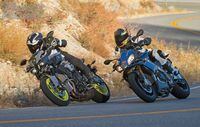
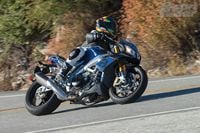
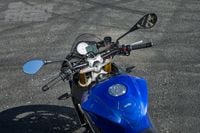
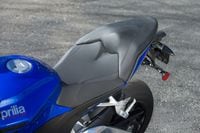
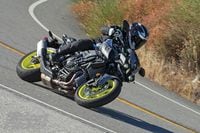
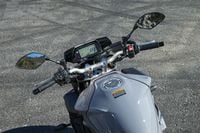
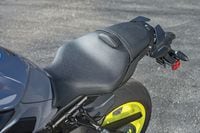
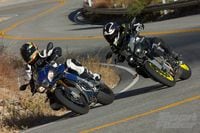
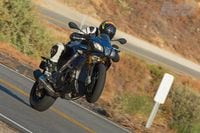
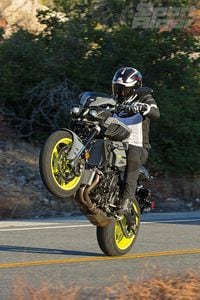
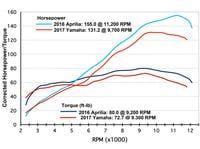
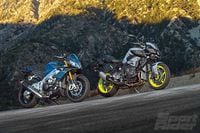
/cloudfront-us-east-1.images.arcpublishing.com/octane/X5TB7BDV4BA2RPSY54ZGK27RP4.jpg)
/cloudfront-us-east-1.images.arcpublishing.com/octane/REUHOJXRDBGZ5IHBYZCCBCISPA.jpg)
/cloudfront-us-east-1.images.arcpublishing.com/octane/52LGJTCKBFEHDF7S7H4CVUIMGM.jpg)
/cloudfront-us-east-1.images.arcpublishing.com/octane/YMWAIPIPSJAOXOU3QMJMGH37OM.jpg)


/cloudfront-us-east-1.images.arcpublishing.com/octane/EJ6KZRGAYBCVXNL2PJXL37UVWQ.jpg)
/cloudfront-us-east-1.images.arcpublishing.com/octane/AAN4TI76M5H5JMUVEIGASWXBDU.jpg)
/cloudfront-us-east-1.images.arcpublishing.com/octane/P3RXD2UCPFF37CMB7CHPVKXORY.jpg)
/cloudfront-us-east-1.images.arcpublishing.com/octane/VZEG2EJI2RDFZNHLRZMU56MD3Q.jpg)
/cloudfront-us-east-1.images.arcpublishing.com/octane/GVJQO5FFOFBWNGODOBRB4FBAW4.jpg)
/cloudfront-us-east-1.images.arcpublishing.com/octane/BIVAK2SFIBDJJM25E7I5VU2FJE.jpg)
/cloudfront-us-east-1.images.arcpublishing.com/octane/CH5VX52UG5CFHOVH5A6UYEFWWA.jpg)
/cloudfront-us-east-1.images.arcpublishing.com/octane/ZVGJNGZRU5C33N7KN23BBFKSC4.jpg)

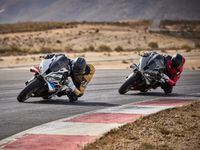
/cloudfront-us-east-1.images.arcpublishing.com/octane/CZ5OM3E43ZEXJHY7LCYXCHLIKI.jpg)
/cloudfront-us-east-1.images.arcpublishing.com/octane/DF5T4K5KPZFJXFCTGPYR77PKJM.jpg)
/cloudfront-us-east-1.images.arcpublishing.com/octane/RMCT2KVQBJHBZMRTSLOVPMOILU.jpg)

/cloudfront-us-east-1.images.arcpublishing.com/octane/K45KB2XHQVA65DX7VN4ZSMT2BI.jpg)
/cloudfront-us-east-1.images.arcpublishing.com/octane/FNHXQQ56BRD7TO4YIJ453PNG2M.jpg)
/cloudfront-us-east-1.images.arcpublishing.com/octane/OIKJC4JA3ZH7BMKUGWYKBIY5FA.jpg)
/cloudfront-us-east-1.images.arcpublishing.com/octane/MT2SAEWY6FDXFBYSLDE3AEFDTM.jpg)